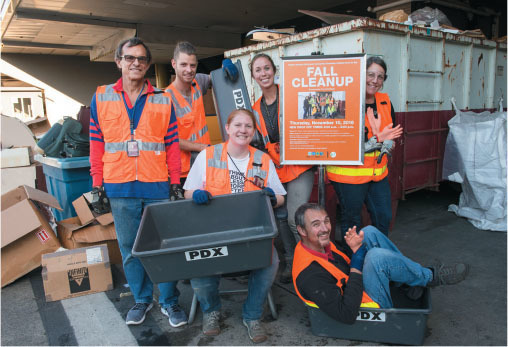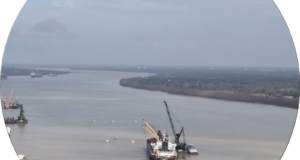
The ports and supply chains that have developed to adapt to growth must now reinvent themselves to better manage their growth – especially as it relates to environmental concerns – but they aren’t doing it alone. They are tackling sustainability goals by collaborating with industry, government, communities, educational institutions and others.
Because ecosystem challenges, especially in supply chains, often cross jurisdictions, no single organization can make the type of systemic changes necessary to reduce economic, societal and environmental stressors. The best approach to sustainability may be to develop partnerships, building bench strength for every contest.
These partnerships can help set goals, build engagement, broaden resources and achieve progress.

Collaborations Evolve
Collaborative start-ups are not always easy, even for organizations that specialize in bringing together stakeholders, regulators, scientific research community and environmental organizations, such as Green Marine, which is a marine industry environmental certification program.
The group’s executive director, David Bolduc, said, “Some of the early meetings could be tense, when designing the initial program requirements. Environmental groups and companies/ports were not used to talking to each other. They would take a firm stance and debate fiercely.”
Fortunately, relationships evolve. Knowledge and understanding of other perspectives engender respect. “With time, they got to know each other…Without giving up their opinion, the tone softened and they were able to find common ground and finally agree on measures that would satisfy both sides,” said Bolduc.
This collaborative approach helped Green Marine become a force in the industry and helped the scope of its environmental certification program grow dramatically.
One of its founding members and an early adopter of sustainability goals and partnerships, Port of Montreal, recently put this collaboration principle to the test. In a unique COVID-era effort, it worked creatively with cruise lines and other vessel operators to winter a record 26 vessels on electric shore power in 2020/21, eliminating some 3,200 tons of emissions.
Employee Engagement
Port employees that are enthusiastic and able to champion integrated sustainability efforts are indispensable. As ports integrate sustainability considerations into every aspect of planning, development, asset management and decision-making, engaged employees are a prerequisite for success.
At the Port of Portland, every department has a diversity, equity and inclusion (DEI) action plan to help increase small business participation, create an equitable, inclusive and welcoming place to work, and engage the community. An environmental planning team reviews and solicits input on capital projects and business transactions, and cross-departmental teams focus on longer-term strategic planning and complex project implementation. Jennifer Bies, director of environmental operations for the port, underscored the significance of this effort: “It’s very important to us because our work in the transportation sector disproportionally impacts marginalized communities and there is urgency to meaningfully address climate change within the next 10 years.”
Port of Long Beach Executive Director Mario Cordero said, “Our port’s commitment to sustainability is in our DNA. It is a part of everything we do, whether it’s our daily operations, how we interact with the public we serve, or the infrastructure projects we undertake to ensure our ongoing success as a gateway for commerce.”
Government Partnerships
Government agencies, such as the U.S. Environmental Protection Agency, that are involved in the quest for sustainability can be fruitful collaborators and supporters. Numerous Diesel Emissions Reduction Act grants have been awarded to support ports. They helped the Puget Sound Clean Air Agency and the Northwest Seaport Alliance (NWSA) replace diesel yard trucks, drayage trucks and engines on harbor vessels with cleaner options, and have partly funded some shore-power installations.
On the Gulf Coast, the Port of Corpus Christi, has signed an MOU with the Department of Energy’s National Renewable Energy Laboratory (NREL). The agreement aims to help port tenants by identifying energy transition and decarbonization projects that need technology and economic analysis, modeling, testing and validation. Sean Strawbridge, the port’s CEO, said the partnership will cultivate opportunities for applied research and analytics and may help develop alternative energy exports.
Educational Outreach
Educational institutions have a role to play, too. The Port of Portland, for example, has worked with Portland State University students for more than 15 years solving waste challenges. Bies said the program provides students with real world experience. “Students…study the waste stream, map back to upstream generators, then work with generators to understand their business and experiment via pilots to see what strategies are effective in reducing waste,” she said.
Such programs advance waste management science and help develop the future talent pool.
The future talent pool of mariners, and their training, can benefit from partnerships, too. The Maritime Administration, or MARAD, has embarked on a National Security Multi-Mission Vessel program that will construct several ships to modernize training at maritime academies, supporting the long-term viability of the nation’s merchant marine. The ships will also have a role in supporting humanitarian assistance and disaster relief missions.
At a December keel-laying event, RADM Michael Alfultis, president of the State University of New York Maritime College, said “This historic maritime event is the realization of a vision many years in the making made possible by the partnership between the state Maritime Academy presidents, the Department of Transportation, the Maritime Administration and members of Congress.”
Act Globally, Act Locally
The Port Authority of New York and New Jersey sustainability partnership program acknowledges that meeting the climate challenge requires collaboration across governments, businesses and consumers. It establishes multi-sector, local and global partnerships to share and scale transportation decarbonization solutions.

The port’s net-zero ambitions include collaborations with entities such as World Ports Climate Action Program, NREL and ClimAid (a New York State climate-change impact and mitigation initiative). The port has myriad community initiatives too. Its environmental education toolkit, developed with educators, includes an interactive online program for students, educators and parents, to inspire the next generation to learn about sustainability through engaging animation, videos and games.
At the Port of Long Beach, already known for its pioneering green-port policy, Cordero said the community is an all-important partner in sustainability efforts. “We’re demonstrating that good jobs and economic development need not come at the cost of environmental sustainability. It’s nothing less than the community demands and it’s what we deliver,” Cordero said.
The port’s Community Grants Program is novel and far-reaching. It has set aside $65+ million for community-generated projects to reduce the port’s impact, making it the largest voluntary port mitigation initiative in the country. “It was created to help those in the community who are most vulnerable to port-related impacts,” especially those related to port-related air pollution, said Cordero. Projects have included air filtration enhancements at local schools and other public facilities, mobile asthma clinics, solar electricity and heat generation, energy-efficient outdoor lighting and an electric bus program.
Upstream Colleagues
Equipment manufacturers and technology providers partner with ports, sometimes to develop a novel solution to an emerging problem, sometimes to create pathways for information exchanges that decrease downtime, improve safety or enhance efficiency. Konecranes, for example, offers a fleet management system that automates visibility over the status of each straddle carrier to optimize maintenance schedules and reduce lost-time accidents.
At the Port of Montreal, a collaborative effort with fuel provider Geenfield Global has been established to develop green hydrogen, ethanol and methanol as fuel sources that are less energy-intensive than traditional port and carrier fuels.
Defining Goals
NWSA recently partnered with the Port of Tacoma, Port of Seattle and Vancouver Fraser Port Authority, updating their Northwest Ports Clean Air Strategy. It aspires to ultimately eliminate air pollutants and greenhouse gas emissions from seaport activities in the regional air shed. It is, essentially, “a shared strategic framework for actions and investments that create a level playing field across the four participating port entities, and helps them coordinate, collaborate, and hold each other accountable,” according to the report’s executive summary. With plans to phase out emissions from seaport activities by 2050, joint objectives and actions are being rolled out. “We consider this to be the centerpiece of our broad sustainability initiatives,” said Steve Nicholas, NWSA senior manager of air quality and sustainable practices. The five-year action plan to advance the 30-year vision has 46 milestones, he said.
Trucking on Your Side
Port stakeholders of all sorts – consultants, contractors, tenants, service providers, operators and labor – are joining collaborations for sustainability. The trucking industry, for example, is a key partner in clean air initiatives. Recognizing that simply barring aging diesel trucks from a port to reduce emissions could lead to the loss of livelihoods, insightful ports bring truckers into the decision-making. Gateways that have programs to help low-income drivers scrap and replace older-model vehicles with cleaner, newer models are able to both cut emissions and build social equity.
NWSA has such a program. And, recognizing the complexity of the drayage ecosystem, NWSA is working with truck fleet operators, truck manufacturers, government agencies, near-port community groups and others in a Puget Sound zero-emission truck collaborative. Nicholas said the group aims to accelerate the transition to zero-emission drayage, charging infrastructure and fueling infrastructure. However, decisions on ways to lower emissions are complicated when it comes to truck emissions in neighboring areas.
“We have documented environmental health disparities in neighboring census tracts,” said Nicholas, some of which may be linked to pollution from the 4,500 trucks serving Seattle and Tacoma harbors. But, many of the trucks are driven by residents of the disadvantaged census tracts.
Terminal and Vessel Operators Join In
Port of Long Beach terminal operators have joined the cause. Last year, SSA Marine, which operates three container terminals at the port, became its first terminal operator to transition to renewable-diesel cargo-handling equipment. The operator expects a 68% decrease in greenhouse gas emissions.
Similarly, at NWSA, Rail Management Services, or RMS, is purchasing six zero-emission electric terminal tractors to move containers between stacks and rail at Tacoma’s South Intermodal Yard. RMS will also purchase charging stations. The NWSA will install electrical infrastructure to support truck charging. The program is supported by DERA and Tacoma Power grants.
Nicholas said the grants were needed to make the investment “pencil out.” He said, “This technology is very expensive compared to diesel technology, and while we know the cost will eventually drop, we must find ways to drive down up-front costs while waiting.”

Broadening Resources
“Meeting the needs of the present while not compromising the ability of future generations to meet their own needs,” defines sustainability, according to Bies. She said Portland operates sustainably when it makes business decisions supporting long-term economic health, integrates community concerns into its work, and reflects a deep commitment to environmental stewardship for the benefit of future generations. Sustainability envelops economic, social and environmental factors. Portland is working in all three areas, not just in environmental aspects, said Bies.

Collaborative sustainability efforts are an imperative. They broaden the vision of an organization. “Engaging with very different groups makes the organization consider new perspectives and solutions,” said Bolduc. Having common goals accelerates and facilitates the adoption of bold new measures.
Sustainability is not inevitable in a time of climate change and environmental PORTLANDdegradation, population growth and overconsumption. Ports are taking the challenge seriously, not only to reduce their environmental footprint but also to optimize their benefit to communities. Ports are partnering with a wide range of stakeholders to do so. These partnerships are proving successful.
Sustainability initiatives do not have to be tackled alone.
 AAPA Seaports
AAPA Seaports


